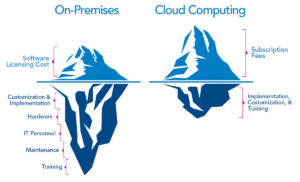
In the previous article, we talked about the pros and cons of NVRs and the pros of VSaaS architectures, now we are going to cover the rest of VSaaS arechitectures’ pros and cons and the hybrid architectures.
VSaaS reduces the total cost of ownership (TCO) even though 1TB of storage in the cloud is often 5 times the cost of 1TB of storage in on-prem disc. VSaaS also acts as a security force multiplier by enabling faster remote review of events that warrant attention.
Indeed, security and reliability become less of an issue for VSaaS solutions as maintenance and software upgrades are all done by the service provider.
Since no on-site server installation and system configuration is needed, users need not to worry about maintaining IT team, hardware breakdown, patch updates and port forwarding.
VSaaS systems will have a continuous deployment of features and will always be secure and up-to-date. A good VSaaS solution is cyber-secure with end-to-end encryption, TLS, and HTTPS. A quality VSaaS solution maintains multiple encrypted copies of the data in the cloud, creating a high availability and redundant solution.

Finally, a cloud solution is more scalable and flexible, allowing the user to expand or reduce camera counts based on their need. As there is no need for physical hardware, scaling and increasing the surveillance area can be done very quickly. New areas can be brought under surveillance by just installing a set of cameras and connecting to the VSaaS.
2.2. VSaaS cons
Yet VSaaS solutions also have certain drawbacks. For one, a reliable Internet connection is always needed to transmit the video data to the cloud. Internet connectivity is always required unless cameras are configured with edge recording. To those ends, bidirectional firewall ports must be opened to allow for recording and viewing of data, Internet access is not always reliable, and the cost of edge recording solutions increases the CAPEX associated with initial installation and the OPEX of its maintenance.
VSaaS require huge bandwidth to the cloud storage/software, and the monthly cost can run into huge figures if there is a lot of cameras.
Further, with the bandwidth constraint, the quality of video may have to be sacrificed. Recording may be lost when Internet connection is disrupted. Bandwidth restrictions may require compromises in image quality and recording rates.
Finally, compared to the NVR architecture which has been in use for some time, cloud is relatively new and as such, the quality of service may vary from vendor to vendor. VSaaS has no standard offering across the market and it is still evolving with service providers are trying to bring new and innovative features in their offerings to attract the users. In such scenario, it is highly possible that certain feature provided by one VSaaS service provider may not be available with others, which may cause an inconvenience to user.
3. Hybrid architecture
Aside from pure NVR and VSaaS setups, more users are considering a hybrid solution which combines elements from both NVR and cloud architectures. There are hybrid solutions available whereby on-prem hardware for management, interfaces to other systems and short-term recording are used, and only long-term recording is moved to the VSaaS. This allows for a lower CAPX investment in hardware, controlled uploads of data to the cloud and lower storage costs given the shared loads.
Hybrid cloud usually deploys NVR locally for 24-7 recording on the premises, and with backup and supplementary event recording or key recording in the cloud. It ensures that the key recordings in the cloud will not be lost if the local NVR fails. Meanwhile, for the hybrid cloud architecture, the NVR, like the camera, is also actively registered in the cloud. When users want to use a mobile phone or cross-site remote access to the NVR, there is no need to configure a public network fixed IP locally and perform NAT port mapping on the router.
In some circumstances, the user can leverage an edge recording hybrid solution whereby the video is recorded to the camera’s own SD card first and then offloaded to the cloud. This has the advantage of having no additional hardware required.
Most newer cameras provide what is known as ‘edge recording’ capability where video can be recorded on an SD card in the camera. With the introduction of higher and higher capacity SD cards, this can allow weeks or even months of video recording to be stored on the camera, eliminating the need for an NVR.
Edge storage can create efficiencies: it will make the utilization of bandwidth far more efficient by only uploading reference images during high demand periods and the uploading the rest of the data at off-peak times. This can have an impact on system performance if data is required urgently as it means the system needs to tunnel to the edge storage to retrieve the data. However, all solutions have their benefits and in most non-critical applications, such a solution can make a lot of sense in the current market.
Adapted from a&s Magazine



































































